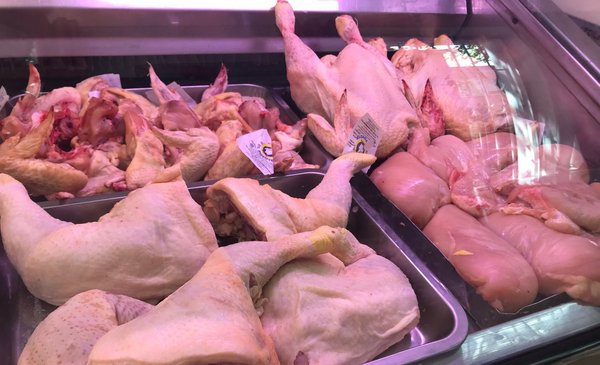The Ministry of Livestock, Agriculture and Fisheries (MGAP) released a “significant” number of import permits in the last few hours from poultry meat that they were pending to increase the local offer and reduce its sale price to the public. “It is a significant volume and we hope that it will have an impact in the coming weeks as this merchandise begins to arrive in the country,” an official source told The Observer.
The President of the Republic, Luis Lacalle Pou, declared this Tuesday at the inauguration of the National Expoactiva that there would soon be “news on some prices of fundamental inputs” for the consumer basket. The president clarified that the measures will be different depending on the type of product but did not give further details.
According to the monthly price report for February published by the Ministry of Economy and Finance, the kg of chicken in the main supermarket chains in Uruguay ranges from $157 to $170 per kg. Meanwhile, in butcher shops, the price of chicken is currently between $130 to $170 per kg.
“In Uruguay the price of chicken meat is cheaper than other proteins such as beef, but compared to other countries it is expensive,” the source explained. For this reason, it was that the Executive Power took as first step “speed up permissions” that different private agents had presented to the MGAP authorities.
According to customs data, So far this year, 523 tons of poultry meat have been imported, with an average price of US$3.29 per kg (about $1.40). The The main origin of Uruguayan chicken imports is Chile (79%), followed by Brazil (13%) and USA (8%). This greater volume of “cheaper” chicken from abroad should make access to this protein cheaper for Uruguayans, the second most important behind the vaccine. Also, that A larger volume of imported chicken should lead to a reduction in the prices set by the Uruguayan poultry industry for domestic consumption. Uruguay is not currently a competitive country to export poultry meat because its production costs are higher than other international suppliers.
Chicken consumption has accelerated considerably in the last three years and would have reached 23.2 kg in 2021, which marks a growth of 27% in that period. In 2018, consumption per person was 18.3 kg, according to INAC data.
beef flies
Taking the three most demanded products in neighborhood butcher shopsthe price of minced meat currently ranges from $250 to $400 per kg, that of the roast from $290 to $450 and the price of butt pulp to make milanese steaks already cut ranges from $450 to $550.
Meanwhile, the kg of breaded chicken milanesa costs $280 per kg in the butcher shops compared to the $350 flat for beef, reported a butcher.
The source of Executive power indicated that the government can “do little” for intervene in the market since beef prices “are expensive all over the world”.
The value of fat steer —that the industry buys from Uruguayan producers— is at record levels with a price of US$ 5 per kg for meat (about $220). In addition, the effect of the war between Russia and Ukraine, “which are the breadbaskets of the world”, is causing a sharp rise in the value of wheat and corn, grains widely used for fattening animals that later go to slaughter.
For this reason, the government considers it “unlikely” to reach some type of price agreement with the refrigerators to set prices for some popular cuts for supply. “Maybe more can be done on the tax side. That’s the reality,” he said.
Last Monday, the Executive Committee of the Colorado Party (CEN) handled as a proposal the possibility of eliminating the minimum VAT (10%) on a series of items in the consumer basket.
At the time, it was managed that Paraguay could emerge as an important supplier for Uruguay, taking into account the loss of the Russian market and the fact that it had containers in the port of Montevideo that were destined for that country. However, the demand for beef is “so high” that Paraguayan industrialists did not find it difficult to “redirect” that beef to markets such as Chile or the Middle East.
Anyway, since the price of the steer in Paraguay —which is not authorized to export to China— It trades today at US$ 3.30 per kg for meat, It is “very feasible” that a greater volume of Paraguayan meat than usual will enter, explained the government source.
Between 2017 and 2020 (the latest official data), the average consumer in the country went from consuming 54.6 kg of beef to 45.7 kg annually, a retraction of 16.3%, according to INAC. Despite this, Uruguay has historically fought for first place in the world in per capita beef consumption with Argentina.
The average price of a ton of beef exported from Uruguay in the last 30 days to March 5 was US$ 4,938 per ton; A year ago its value was US$3,975 (+24%), according to INAC data. Sales to the Chinese market, the main customer, have increased 73% so far this year, to US$329.4 million.







